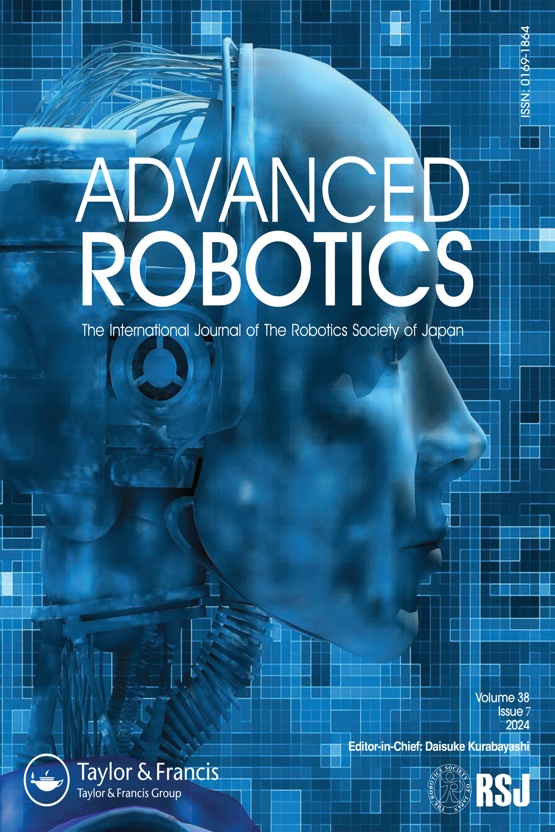Submit a Manuscript to the Journal
Advanced Robotics
For a Special Issue on
Robot and Human Interactive Communication
Manuscript deadline

Special Issue Editor(s)
Prof. Kazuhiro Nakadai,
Institute of Science Tokyo
nakadai@ra.sc.eng.isct.ac.jp
Dr. Emilia Barakova,
Eindhoven University of Technology, The Netherlands
Prof. Somaya Ben Allouch,
University of Amsterdam/University of Applied Sciences Amsterdam, The Netherlands
Prof. Goldie Nejat,
University of Tronto, Canada
Dr. Patrick Holthaus,
University of Hertfordshire, UK
Dr. Heqiu Song,
RWTH Aachen University, Germany
Dr. Zhi Zheng,
University of Notre Dame, France
Prof. Tetsunari Inamura,
Tamagawa University, Japan
Robot and Human Interactive Communication
Guest Editors (Continued from the upper column):
Prof. Anara Sandygulova, Nazarbayev University, Kazakstan
Dr. Gabriele Trovato, Shibaura Institute of Technology, Japan
Dr. Maartje DeGraaf, Utrecht University, The Netherlands
Dr. Shruti Chandra, University of Northern British Columbia, Canada
Dr. Andy Elliot Ricci, Bates College, USA
Dr. Masahiro Shiomi, Interaction Science Laboratories ATR, Japan
Prof. Silvia Rossi, Università degli Studi di Napoli Federico II, Italy
Dr. Yuan Feng, Northwestern Polytechnical University, China
Dr. Barbara Bruno, Karlsruhe Institute of Technology, Germany
Prof. Astrid Rosenthal von Der Pütten, RWTH Aachen University, Germany
The main purpose of this special issue is to publish state-of-the-art research outcomes, recent advances, and future perspectives relating to robot and human interactive communication. Based on this aim, the special issue is open to all thematic areas related to human-robot interaction. It will also carry revised and substantially extended versions[1] of selected papers presented at the main conference and workshops of the 34th IEEE International Conference on Robot and Human Interactive Communication (RO-MAN 2025).
Under the theme “Shaping our hybrid future with robots together,” the special issue will cover a broad range of topics toward realizing a society where humans and robots coexist and collaborate. It includes theories, methodologies, technologies, empirical and experimental studies, as well as research related to robotics, psychology, cognitive science, artificial intelligence, human factors, ethics and policy, and interaction-based robot design. Topics of the special issue include, but are not limited to:
• Applications of Social Robots
• Assistive Robotics
• Cognitive and Sensorimotor Development
• Cognitive Skills and Mental Models
• Computational Architectures
• Cooperation and Collaboration in Human-Robot Teams
• Creating Human-Robot Relationships
• Curiosity, Intentionality and Initiative in Interaction
• Degrees of Autonomy and Teleoperation
• Detecting and Understanding Human Activity
• Embodiment, Empathy and Intersubjectivity
• Ethical Issues in Human-robot Interaction Research
• Evaluation Methods and New Methodologies
• Haptic Interaction Design
• HRI and Collaboration in Manufacturing Environments
• HRI for Sustainability
• Innovative Robot Designs
• Interaction Kinesics
• Interaction with Believable Characters
• Linguistic Communication and Dialogue
• Long-term Experience and Longitudinal HRI Studies
• Machine Learning and Adaptation
• Monitoring of Behaviour and Internal States of Humans
• Motion Planning and Navigation in Human-Centered Environments
• Motivations and Emotions in Robotics
• Multimodal Interaction and Conversational Skills
• Multi-modal Situation Awareness and Spatial Cognition
• Narrative and Story-telling in Interaction
• Non-verbal Cues and Expressiveness
• Novel Interfaces and Interaction Modalities
• Personalities for Robotic or Virtual Characters
• Philosophical Issues in Human-Robot Coexistence
• Robot Companions and Social Robots
• Robots in Education, Therapy and Rehabilitation, Medical and Surgical Applications
• Robots in art and entertainment, and Art pieces supported by robotics
• Robot Perception for Interaction and Communication such as Robot Audition, Robot Vision, etc.
• Robotic Etiquette
• Social Intelligence for Robots
• Social Learning and Skill Acquisition Via Teaching, Imitation, and demonstration
• Social Presence for Robots and Virtual Humans
• Soft and Compliant Robot Design
• Sound Design for Robots
• Story-telling in HRI
• Trust, Transparency, and Explainability in HRI
• User-centered Design of Robots
• Virtual and Augmented Tele-presence Environments for robots and humans
[1] In order for avoiding the copyright violation, please change the title of your paper from the one in the conference as well as include the conference paper to the reference. Also please summarize the novelty of your manuscript (usually after discussing the conference paper) in introduction. You may better revise the figures slightly from the conference paper.
Submission Instructions
1. The full-length manuscript (either PDF file or MS word file) should be sent by the due date to the office of Advanced Robotics, the Robotics Society of Japan through the WEB site of Advanced Robotics (https://www.rsj.or.jp/pub/ar/submission.html) by selecting special issue title "Robot and Human Interactive Communication” when submitting your paper to Submission Portal.
2. Details of different types of papers that will be accepted is Full paper (up to around 6000 words), Short paper (up to around 3500 words), or Survey paper (up to around 12000 words). Please select the paper category from Research Article (Full paper), Short paper, and Survey paper when you submit your manuscript.
3. Sample form of the manuscript as well as the Instruction for Authors is available at the WEB site.
4. Expected publication dates: September 2026 (Advanced Robotics vol. 40, Issue 17)
